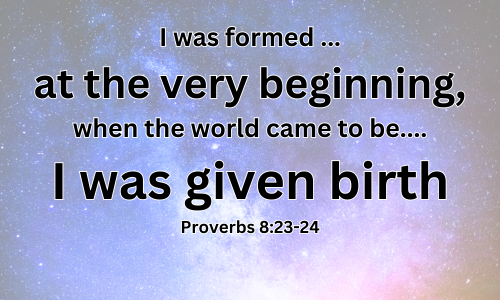When Something Else is God
Before we return to the historical development of Christ-worship, we need to consider another more ancient concept found in the Hebrew Bible, which unfortunately requires special terminology. Proverbs 8 personifies wisdom as a woman, contrasting her with the adulterous woman. These are two alternatives for young men, who typically pursue women. But our wise author gives the young man an out: he can purse the lady wisdom and preserve his life, instead of pursuing the adulteress who will bring only death. But our author does something interesting that goes beyond personification. He says that Lady wisdom was in the beginning, before anything else was created, and she was “beside” God like a master worker during the Creation. In other words, it sounds like she had a role in Creation. This literary device goes beyond mere personification, as it portrays an attribute of God, wisdom, as an entity apart from God. This is called hypostasis. And if you think it sounds familiar, you’re right: the first few verses of John speak of Jesus as the Logos, which was said to be involved in the Creation.
There is another occurrence of something divine being juxtaposed in the Hebrew Bible with God, and that is the “Angel of the Lord.” We’ll come back to the Angel of the Lord and hypostasis in later articles. Here I only want to repeat that angel-worship was in fact a thing in the first century, even if it was condemned by most Jews. I would argue that it probably had very little if any influence on the birth of Christ-worship, as it is condemned in the New Testament.[1]
There is one more Jewish belief around the time of Christ that should be at least mentioned before considering the evidence in the New Testament for how Jesus became divine: it is called the Two Powers in Heaven, and was quashed as heresy in the second to fourth centuries CE. For a full explanation of it, see Alan Segal’s Two Powers in Heaven. Basically, it was a way of understanding some passages that we’ve already considered, such as Daniel 7’s Son of Man, the plural “we” of Genesis 1:26, but also how the elders of Israel could see God in Exodus 34. This of course begs the question of whether Christianity was simply a similar heresy that happened to win.
The idea that Christ worship could have risen internally within Judaism was universally rejected by the religionsgeschichtliche Schule; their assumption that it had to have developed from external pagan polytheistic influence was almost an article of faith that was not well examined. The new religionsgeschichtliche Schule has often considered how Christ-worship appeared to arise within a Jewish context, but not always, as we’ll see. Now that we’ve considered some evidence from their sacred Scriptures before the time of Christ, it is now time to turn to the first century evidence for how Jesus came to be considered divine in some sense. We will also consider in what sense Jesus was considered divine by the New Testament writers, which is perhaps an even more interesting barrel of worms that we won’t mind opening.
[1] Colossians 2:18
